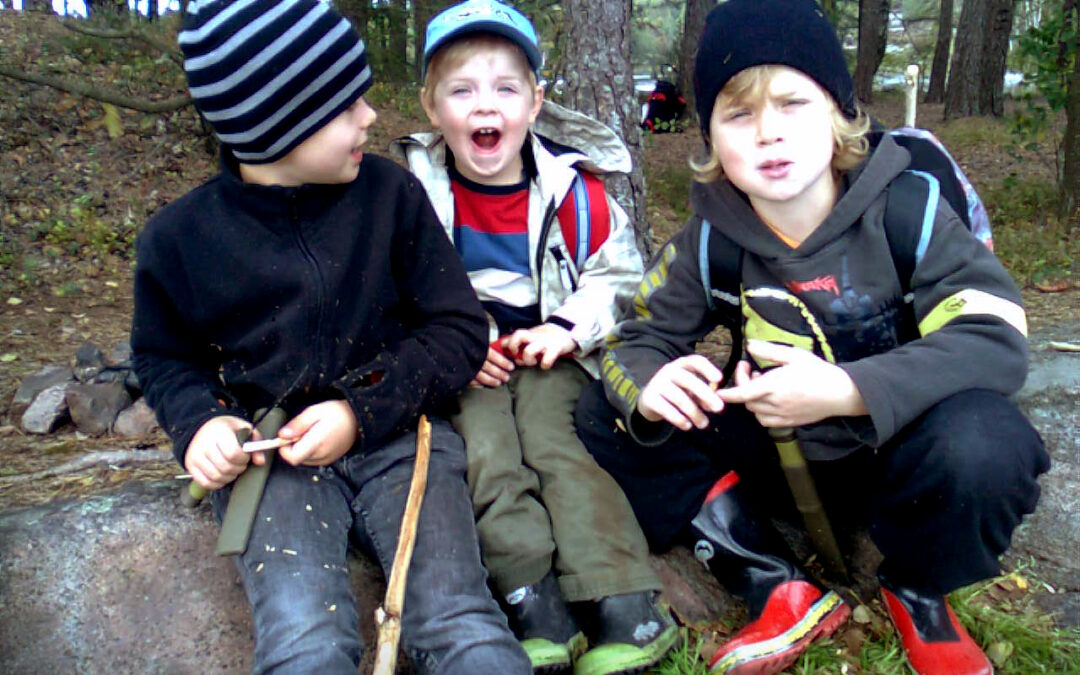I was fortunate to grow up in a time and place where it was quite normal for kids, and boys in particular, to use knives, cutting twigs and branches into various usable items, like sausage sticks, bow and crossbow arrows, staves etc, etc, not to mention a whole lot of other stupid but important experiences, like climbing to the top of tall trees, climbing rock walls, racing downhill on bikes and sleds, jumping from a little too high heights, constantly testing ourselves and our capabilities with resulting bruises, nose bleeds, sprained ankles and every now and then having the wind completely knocked out of ourselves as we fell flat on the ground. In many ways I was far more confident in my body at the age of 12 than I am now as a grown man, despite my martial arts training.
In today’s society however, where we are constantly keeping watch over our children, keeping them safe at all times and curling them away from any danger or negative experiences in life. Fewer and fewer children are allowed to be exposed to potentially harmful things and in doing so we steal away a great opportunity of learning and growing from them.
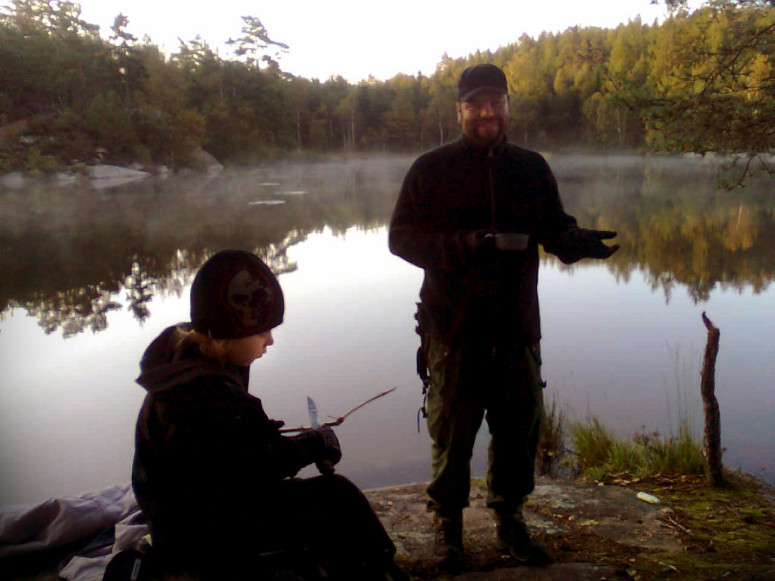 Most people today haven’t even killed anything bigger than a bug, instead relying on others to butcher the animal they are to eat. Many adults feel quite uncomfortable and even anxiety with properly sharp knives and axes in hand. This is a shame as we all lose a personal and deeper contact with the facts of life, that everything dies eventually, and that some life has to die to feed others. At the same time we also more and more lack a real understanding of the weakness, as well as strengths, of our bodies and how we can control such potential dangers quite well if we train for it.
Most people today haven’t even killed anything bigger than a bug, instead relying on others to butcher the animal they are to eat. Many adults feel quite uncomfortable and even anxiety with properly sharp knives and axes in hand. This is a shame as we all lose a personal and deeper contact with the facts of life, that everything dies eventually, and that some life has to die to feed others. At the same time we also more and more lack a real understanding of the weakness, as well as strengths, of our bodies and how we can control such potential dangers quite well if we train for it.
It is all part of life and children shouldn’t be protected from it. Quite the opposite. They should be allowed to grow and develop through the trust we place in them and through that also learn to trust in themselves, growing confident in their own abilities. This is hugely important. And learning to handle a really sharp knife is part of this.
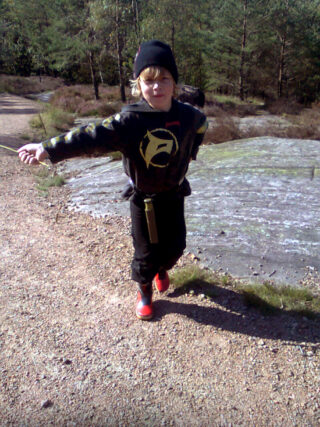 A question I keep seeing asked by parents who are considering this, is at what age kids should be allowed to start practicing with sharp knives. While there is no exact year I let my own boys start using knives at the age of 6-7, increasing the trust I place in them for every year, starting simple and short.
A question I keep seeing asked by parents who are considering this, is at what age kids should be allowed to start practicing with sharp knives. While there is no exact year I let my own boys start using knives at the age of 6-7, increasing the trust I place in them for every year, starting simple and short.
However, it is individual for every child as it depends on their mentality and fine motor skills just as much as it does on their personality and maturity. So others start even sooner. If your kid has decent control over pencils when drawing and cutlery when eating, or overall good control of his or her body when playing, then he or she is probably quite ready to start practicing with sharp knives too. If so, then it is time to teach them to use and respect, but not fear knives.
So what knives should you get your kids?
To begin with I don’t think it should be any less sharp than a knife for adults, and in fact you can let them use regular Mora knives, although the type with a lower finger guard is advisable as that protects from having the fingers slide onto the edge. There are knives designed specifically for kids too, like the Mora Scout knife below. They are just as sharp as regular adult Moras, which I think is necessary, as less sharp knives can still cause injury but are harder to work with, requiring unnecessary force to use, thus in fact increasing the risk of bad habits and injury.
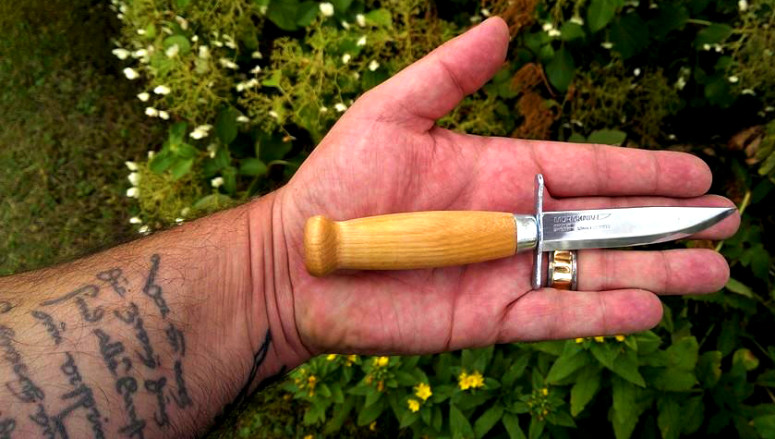 This design also comes in a “safe” version with a rounded point to lessen the risk for piercing injuries. In my opinion though, the upper finger guard is problematic as it hinders certain grips without really adding any greater degree of safety. For that reason I consider the knife below to be ideal; the Mora Woodcarving Knife Jr.
This design also comes in a “safe” version with a rounded point to lessen the risk for piercing injuries. In my opinion though, the upper finger guard is problematic as it hinders certain grips without really adding any greater degree of safety. For that reason I consider the knife below to be ideal; the Mora Woodcarving Knife Jr.
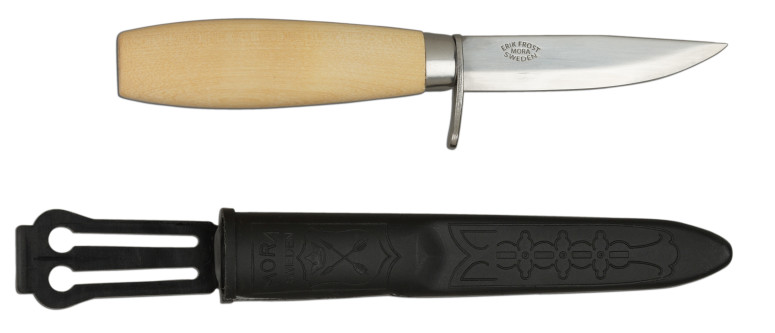
So, your child now has a good knife to start working with. What then are the pieces of advice and good knife habits that you should confer to your child? Here are a few tips that I tell my kids. Most things really need to be shown in person, but if you have at least a little bit of experience in the topic then you will understand what I speak of. If not, then you have to learn to use the knife yourself first and carefully consider the implications and the reasoning behind the advice given here.
So without further ado, here goes:
10 pieces of advice on knife handling
- The most important thing you can do with a knife, when you are in the woods far away from other people, is to not hurt yourself. Same goes for everything when you are away from civilization. Never take unnecessary risks like climbing rocks, swimming in streams etc.
- Always cut away from yourself and never towards your legs, feet, other hand etc.
- Knives cut the worst when you draw them back or forth in the direction of the blade.
- A regular knife cuts in the direction of the edge. This means sliding it in the opposite direction is quite safe. That way you can clean a blade even against your pants or your arm.
- Never walk or run in front of someone who is using a knife or an axe without telling them beforehand.
- Never walk around with a knife out of the sheath. If you absolutely have to, then extend it out towards your side as you walk, so you can drop it if you fall.
- If you need to hand the knife over to someone else, then hold the knife by the blade, with the back of the blade towards your palm, pressing the flats of the blade with your thumb and index finger, as you hand it over.
- To make the carving of wood easier you can put either thumb on the back of the blade, pressing it down as you carve. Just make sure you don’t put your index finger in the direction where you carve so you end up cutting your finger. You are the strongest when cutting near the hand, but the point can be used for more delicate tasks.
- Use the proper knife for the task. Smaller and medium-sized knives are good for most tasks, but not for chopping larger pieces of wood. Likewise, large, heavy knives are pretty good for chopping twigs and branches, but not great for other tasks like woodcarving, food preparation, gutting fish etc. Two different knives are good to have and to learn to use.
- Sweat and water, even touching the steel, will cause it to rust, so you need to clean it afterwards and then dry it off.
That’s it! Those are the things I teach my boys to begin with.
Now, how do you practice these rules?
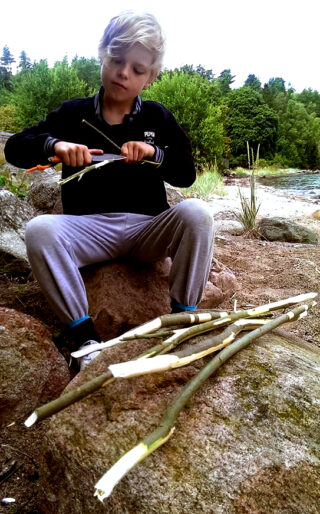 Basically it is just a matter of sitting down with your kids with both of you carving things, using good habits as you do so. Just go out into the woods and cut down some twigs and clean them off of smaller twigs protruding from the centre.
Basically it is just a matter of sitting down with your kids with both of you carving things, using good habits as you do so. Just go out into the woods and cut down some twigs and clean them off of smaller twigs protruding from the centre.
Work on carving nice points using different grips, pressing against the back of the blade with either thumb. The finer and rounder the point, the better. It will require some rough carving at first, followed by finer and finer carving.
Teach them how to slice and how to scrape away bark and fine wood chips with the knife at a straight angle. Teach them to carve thin slices of wood with one hand to begin with. Later you can teach them to do it with both hands, the off hand pressing down on the back edge.
Create patterns in the bark by pressing the blade down as you rotate the stick and then just strip away parts of the bark working with the point and thumbs. Many kids love this, as they get to be creative in pattern designs. You can even create neat spiral patterns.
Walk over to your child and hand over your knife so they can try it. Then ask them to give it back. Occassionally ask your child to come over so you can show them things, and through that teach them how to approach you with their knife. Teach them to always put the knife in the sheath or at least extend the arm out towards the side as they walk. Show them how to clean the knife of chips and grime by drawing the blade away from the edge against your pant leg or your arm.
There are many more things you can do, but this is a start, to get things going. Have fun, and be safe, and remember to not protect your kids too much. It is no catastrophy if they cut themselves and a finger bleeds. They will learn something useful from it. Something necessary even. And through that grow.

